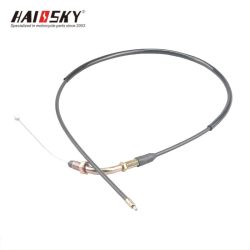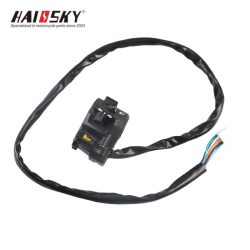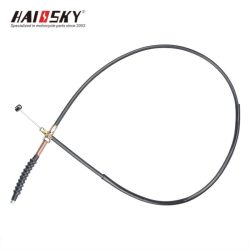OEM Motorcycle Parts
Category: Motorcycle Handlebar Controls - Levers, Cables & Switches
Everything You Need to Know About Motorcycle Crankcases
The motorcycle crankcase is one of the most critical components of a motorcycle’s engine. It houses the crankshaft, connecting rods, and other essential internal parts, ensuring the engine operates smoothly and efficiently. At Haissky.com, we specialize in providing high-quality motorcycle crankcases to B2B wholesalers and riders. In this guide, we’ll explore the types of crankcases, their functions, maintenance tips, and how to choose the right crankcase for your motorcycle. We’ll also answer some frequently asked questions to help you make informed decisions.
What Is a Motorcycle Crankcase?
A motorcycle crankcase is the engine component that encloses the crankshaft, connecting rods, and other moving parts. It serves as the foundation of the engine, providing structural support and protecting internal components from dirt, debris, and external damage. The crankcase also plays a vital role in lubricating the engine by holding and circulating oil.
Types of Motorcycle Crankcases
Motorcycle crankcases come in various designs to suit different engine types and performance needs. Here are the most common types:
1. Split Crankcase
Split crankcases are made up of two or more sections that are bolted together. This design allows for easier assembly and disassembly during maintenance or repairs.
Pros: Easy to service, versatile, and widely used in modern motorcycles.
Cons: Requires precise alignment during assembly to prevent leaks.
2. Unitized Crankcase
Unitized crankcases are a single-piece design where the crankcase and cylinder block are integrated. This design is commonly found in smaller engines or scooters.
Pros: Lightweight, compact, and reduces the risk of oil leaks.
Cons: More challenging to repair or replace individual components.
3. Dry Sump Crankcase
Dry sump crankcases use an external oil reservoir instead of storing oil in the crankcase. This design is popular in high-performance and racing motorcycles.
Pros: Improved oil circulation, reduced oil starvation, and better engine performance.
Cons: More complex and expensive to maintain.
4. Wet Sump Crankcase
Wet sump crankcases store oil in the bottom of the crankcase, which is then circulated through the engine by an oil pump. This design is common in most standard motorcycles.
Pros: Simple, cost-effective, and easy to maintain.
Cons: Prone to oil starvation during aggressive riding or high-speed maneuvers.
Functions of a Motorcycle Crankcase
The crankcase performs several essential functions, including:
Protecting Internal Components: It shields the crankshaft, connecting rods, and other parts from dirt, debris, and damage.
Oil Circulation: The crankcase holds and circulates oil to lubricate the engine, reducing friction and wear.
Structural Support: It provides a sturdy foundation for the engine, ensuring all components are properly aligned.
Heat Dissipation: The crankcase helps dissipate heat generated by the engine, preventing overheating.
Maintenance Tips for Motorcycle Crankcases
Proper maintenance ensures the longevity and performance of your motorcycle crankcase. Here are some key tips:
1. Regular Oil Changes
Change the engine oil and oil filter at regular intervals to ensure proper lubrication and prevent sludge buildup.
2. Inspect for Leaks
Check the crankcase for oil leaks, especially around gaskets and seals. Replace worn-out gaskets immediately to prevent further damage.
3. Clean the Crankcase
Keep the crankcase clean by removing dirt and debris. Use a mild detergent and avoid harsh chemicals that can damage the surface.
4. Monitor Oil Levels
Regularly check the oil level and top it up if necessary. Low oil levels can lead to engine damage.
5. Check for Cracks or Damage
Inspect the crankcase for cracks, dents, or other damage. If any issues are found, repair or replace the crankcase promptly.
6. Use High-Quality Oil
Always use high-quality engine oil that meets the manufacturer’s specifications.
How to Choose the Right Motorcycle Crankcase
Selecting the right crankcase depends on your motorcycle’s engine type, performance needs, and maintenance preferences. Here are some factors to consider:
1. Engine Compatibility
Ensure the crankcase is compatible with your motorcycle’s make and model.
2. Material
Crankcases are typically made from aluminum or magnesium. Aluminum is lightweight and durable, while magnesium offers better heat dissipation.
3. Design
Choose between split, unitized, dry sump, or wet sump designs based on your engine type and performance requirements.
4. Ease of Maintenance
If you prefer easy maintenance, opt for a split crankcase design.
5. Performance Needs
For high-performance or racing motorcycles, consider a dry sump crankcase for improved oil circulation and engine performance.
6. Budget
Set a budget and choose a crankcase that offers the best value for money without compromising on quality.
How to Replace a Motorcycle Crankcase
Replacing a motorcycle crankcase is a complex task that requires mechanical expertise. Here’s a step-by-step guide:
Tools Needed:
Socket set
Torque wrench
Screwdrivers
Gasket scraper
New crankcase and gaskets
Engine oil
Steps:
Prepare the Motorcycle: Place the bike on a stable, level surface and remove the engine covers.
Drain the Oil: Drain the engine oil and remove the oil filter.
Disassemble the Engine: Remove the bolts securing the crankcase and carefully separate the two halves.
Remove the Old Crankcase: Detach the crankshaft, connecting rods, and other components from the old crankcase.
Install the New Crankcase: Position the new crankcase and reassemble the engine components. Use new gaskets to ensure a proper seal.
Reassemble the Engine: Bolt the crankcase halves together and torque the bolts to the manufacturer’s specifications.
Refill the Oil: Add fresh engine oil and replace the oil filter.
Test the Engine: Start the engine and check for leaks or unusual noises.
Frequently Asked Questions
Q1: Why do bikers have their handlebars so high?
High handlebars provide a more upright and comfortable riding position, reducing strain on the back and shoulders during long rides.
Q2: What is the purpose of the handlebar brace?
A handlebar brace provides additional support and stability to the handlebars, reducing vibrations and improving control.
Q3: How to fix handlebar alignment?
Loosen the handlebar clamps, adjust the handlebars to the desired position, and tighten the clamps securely.
Q4: Are handlebar upgrades worth it?
Yes, handlebar upgrades can improve comfort, control, and aesthetics, depending on the rider’s preferences and needs.
Q5: Why do bikers hang ropes on their handlebars?
Ropes on handlebars are often used as a makeshift tool for securing cargo or as a decorative element.
Q6: Why do girls’ bikes have a lower bar?
Girls’ bikes traditionally have a lower bar to make it easier to mount and dismount while wearing skirts or dresses.
Conclusion
The motorcycle crankcase is a vital component that ensures the smooth operation and longevity of your engine. Whether you’re a B2B wholesaler or a rider, understanding the types, functions, and maintenance of crankcases is essential for optimal performance.
At Haissky.com, we offer a wide range of high-quality motorcycle crankcases designed to meet the needs of every rider. Explore our collection today and find the perfect crankcase for your inventory or personal use!
















